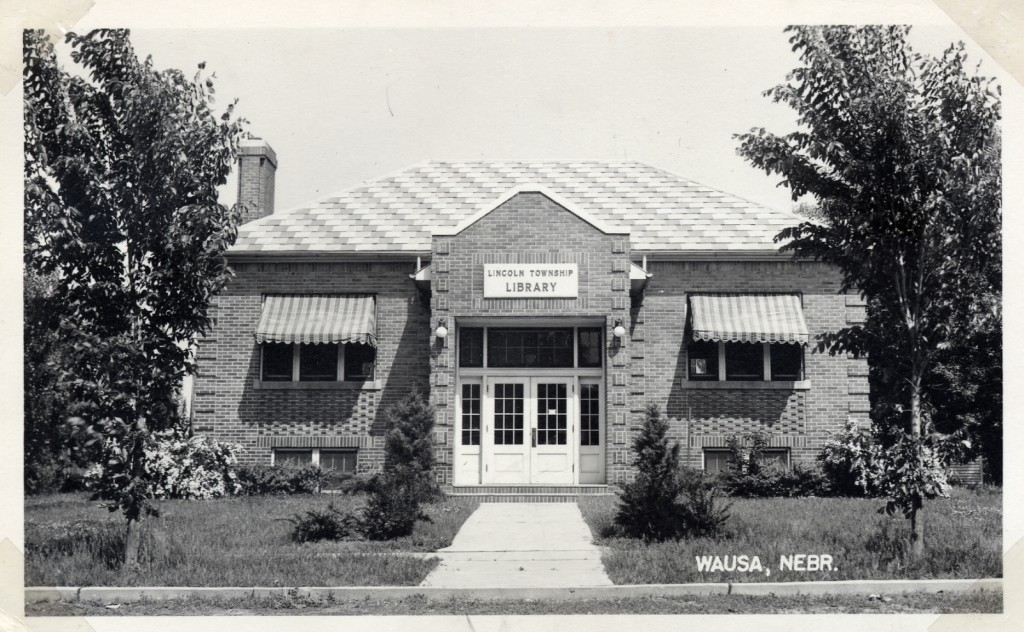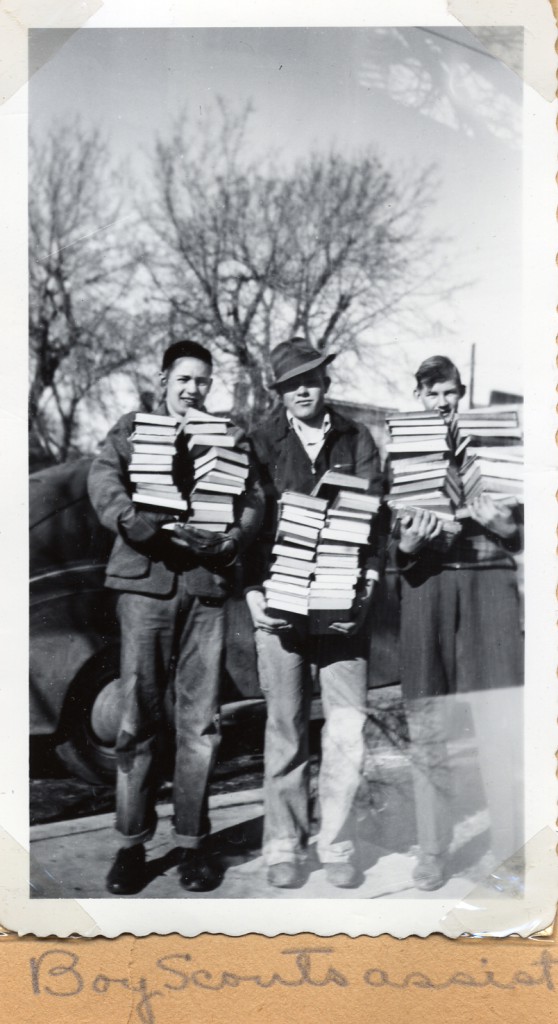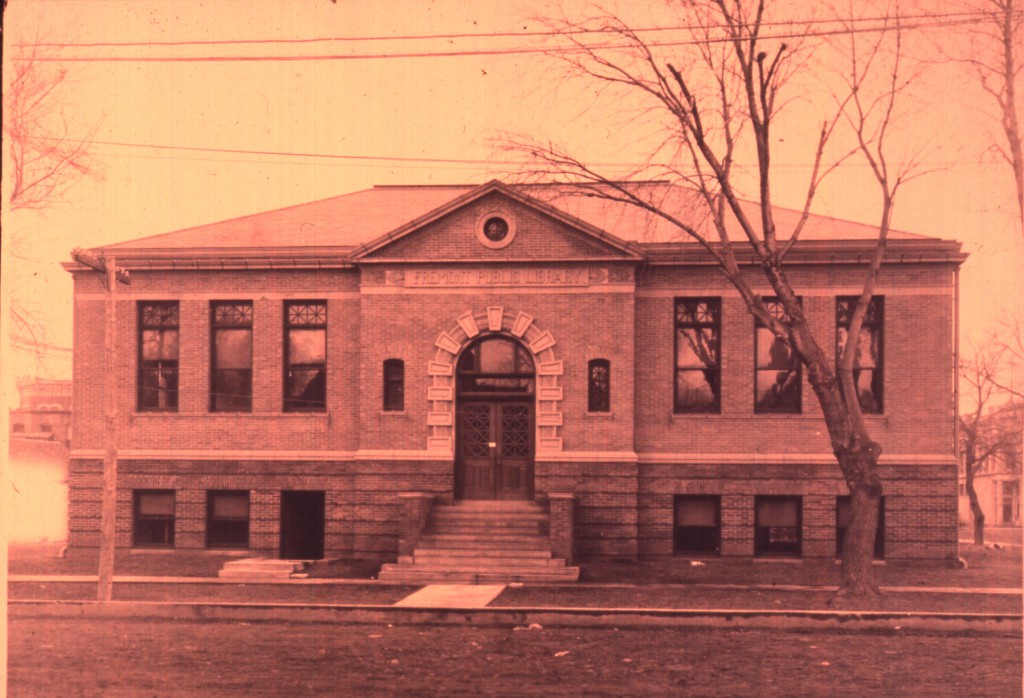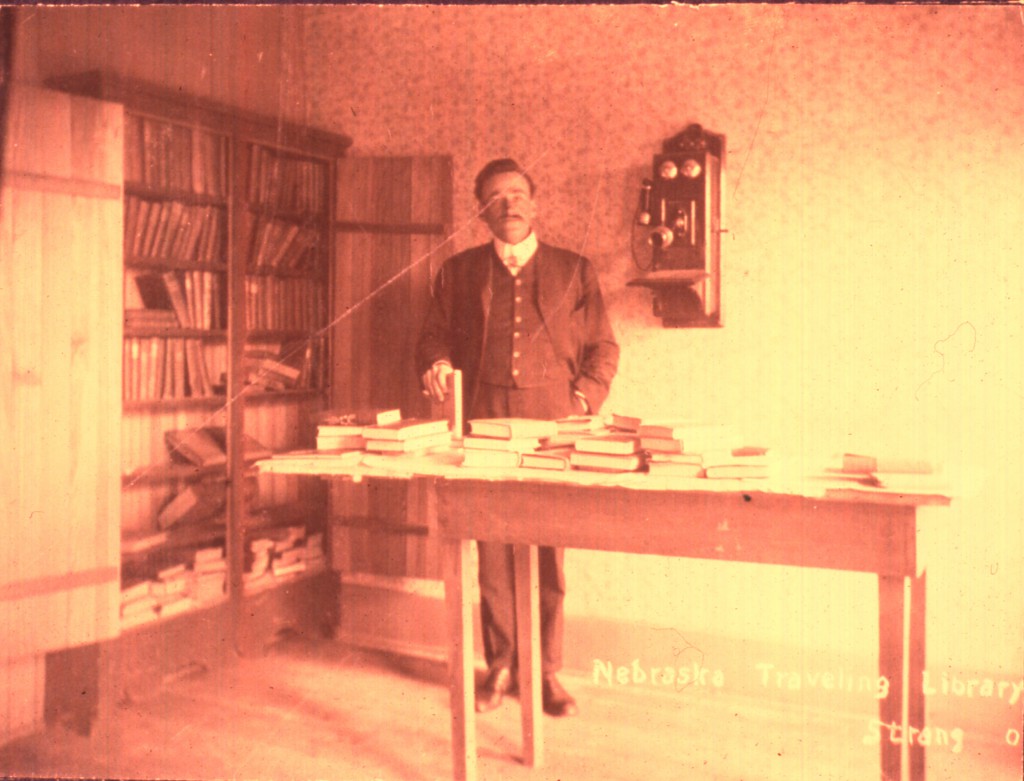Search the Blog
Categories
- Books & Reading
- Broadband Buzz
- Census
- Education & Training
- General
- Grants
- Information Resources
- Library Management
- Nebraska Center for the Book
- Nebraska Memories
- Now hiring @ your library
- Preservation
- Pretty Sweet Tech
- Programming
- Public Library Boards of Trustees
- Public Relations
- Talking Book & Braille Service (TBBS)
- Technology
- Uncategorized
- What's Up Doc / Govdocs
- Youth Services
Archives
Subscribe
Category Archives: General
Throwback Thursday: Photo of Lincoln Township Library, Wausa, Nebraska, circa 1941-1943
Posted in General
Leave a comment
Apply by Jan. 28, 2015 for “The Big Read” Grants
The Big Read is accepting applications for grants between $2,500 and $20,000. The Big Read supports organizations across the country in developing community-wide programs which encourage reading and participation by diverse audiences. Nebraska libraries are invited to apply before Jan. 28, 2015. Visit the Application Process page at http://neabigread.org/application_process.php for more information.
Posted in Books & Reading, General, Programming, Public Relations
Leave a comment
The Data Dude – New Data Elements
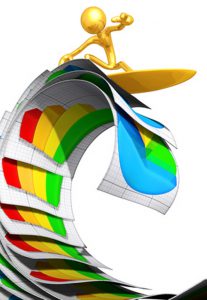 The Data Dude recently attended the SDC (State Data Coordinator) conference in Louisville, KY. The Dude votes thumbs up on the conference sessions, the city of Louisville (its all about horses and bourbon), and the invaluable time spent with colleagues from other states. The Dude votes thumbs down on flight delays and the anxiety producing craziness of the typical airport. The purpose in writing today is to explore what data elements are important to you, the actual people that capture and record these statistics on the annual public library survey (affectionately known to many as the “Bibliostat One” and unaffectionately known as many other things). Are there statistics you are collecting that you think might be important on a state or national level? Please let me know, or even let me know some general ideas or thoughts you might be having, so they might be explored further or built upon. A few things were discussed at the SDC conference that are worth noting and might jog your ability to collaborate creatively. Number one: Virtual library visits. As physical visits may be declining, it probably is important to track virtual visitors to the library (e.g. visitors to the library website). Some states already collect this data. Does your library track this information? If so, does it underline the importance of your website, and perhaps more importantly, keeping it updated?
The Data Dude recently attended the SDC (State Data Coordinator) conference in Louisville, KY. The Dude votes thumbs up on the conference sessions, the city of Louisville (its all about horses and bourbon), and the invaluable time spent with colleagues from other states. The Dude votes thumbs down on flight delays and the anxiety producing craziness of the typical airport. The purpose in writing today is to explore what data elements are important to you, the actual people that capture and record these statistics on the annual public library survey (affectionately known to many as the “Bibliostat One” and unaffectionately known as many other things). Are there statistics you are collecting that you think might be important on a state or national level? Please let me know, or even let me know some general ideas or thoughts you might be having, so they might be explored further or built upon. A few things were discussed at the SDC conference that are worth noting and might jog your ability to collaborate creatively. Number one: Virtual library visits. As physical visits may be declining, it probably is important to track virtual visitors to the library (e.g. visitors to the library website). Some states already collect this data. Does your library track this information? If so, does it underline the importance of your website, and perhaps more importantly, keeping it updated?
Secondly, how many of you use non-pc devices? The thing that immediately comes to mind would be the 3D printer; however, what about other non-pc devices such as tablet computers? I know many libraries make these available in lieu of the traditional PC. For those of you with tethered (or non-tethered) tablets, are you counting and reporting those now, or would this fit more appropriately under a separate data element called “non-pc devices”? With the recently concluded digital inclusion survey (Nebraska scored a stellar 64% response rate), how about broadband speed? I know of a few libraries that completed the speed test, looked at the low numbers and said, “wait a minute…”. They used this as a catalyst to talk to their ISP and found out they were getting the shaft (maybe intentionally, maybe not) when it came to what they were paying for. The point is that the DI Survey uncovered these gross injustices, and the librarians took action to remedy them. The question that remains is: Would actual speed reporting be beneficial, or are there simply too many variables in place to capture it accurately?
Furthermore, new library services that may be worth noting in data collection include self-directed education and local digital collections. Is there anything else on your list? I’ve already starting thinking about next year’s survey and perhaps some tools to help you with using the compiled data. Capturing uses of electronic resources continues to be problematic. There are numerous download services that libraries might subscribe to. If the library pays for it, and the virtual library visitor uses it, shouldn’t we somehow try to paint a picture of its use? Many of these things are currently lumped into the “database” bin and counted as boring ol’ “1”, simply because there is no other definition that they fit into. I wonder if instead of trying to write a definitino that captures all of these services, perhaps we should simply add a three part question to provide a more accurate portrayal: (1) Does your library subscribe to an electronic downloadable or streaming service; (2) if so, what is the name of the service; and (3) how many times does it get used in a year. The survey could provide a prompt to enter this information for each subscribed service and a separate element could do the calculations for the total uses of all downloadable services. Shaka.
Throwback Thursday: Nebraska Public Library Commission Bookmobile, circa 1930’s
Children from School District 8 come out to meet the Nebraska Public Library Commission Bookmobile, circa 1930’s.
Posted in Books & Reading, General, Nebraska Memories
Leave a comment
The Data Dude – Public Library Survey (reporting OverDrive)
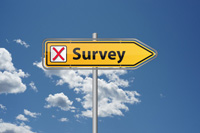 Shaka. For this week, the Data Dude reminds you of the annual Public Library Survey sponsored by the Institute of Museum and Library Services (IMLS). The survey is important because the completion of it is tied into State Aid if you are accredited, and Dollar$ for Data (actual cash money) if you are not accredited. You may work on the survey a little at a time, picking up where you’ve left off (make sure you click on the red “save” button at the bottom or top of each page). If you have any questions throughout the process, please contact me. The deadline for submission is February 13, 2015. There are tips and instructions on the Bibliostat section of the NLC website. This is also where you log in to the survey. The purpose in writing today is to provide a few tips about the potentially unpleasant method of reporting eBook and Audiobook downloads. If you are in the OverDrive consortium and were a member when statistics were reported last year, the following guide will help you with your reporting. If you recently joined, you need to tweak the numbers below a bit. For the new people, on elements 4.5 and 4.13 (previous year’s holdings), the number would be “0”, and you would add the 4.8 and 4.16 totals into element 4.6 so that you get the same numbers for 4.8 and 4.16 below.
Shaka. For this week, the Data Dude reminds you of the annual Public Library Survey sponsored by the Institute of Museum and Library Services (IMLS). The survey is important because the completion of it is tied into State Aid if you are accredited, and Dollar$ for Data (actual cash money) if you are not accredited. You may work on the survey a little at a time, picking up where you’ve left off (make sure you click on the red “save” button at the bottom or top of each page). If you have any questions throughout the process, please contact me. The deadline for submission is February 13, 2015. There are tips and instructions on the Bibliostat section of the NLC website. This is also where you log in to the survey. The purpose in writing today is to provide a few tips about the potentially unpleasant method of reporting eBook and Audiobook downloads. If you are in the OverDrive consortium and were a member when statistics were reported last year, the following guide will help you with your reporting. If you recently joined, you need to tweak the numbers below a bit. For the new people, on elements 4.5 and 4.13 (previous year’s holdings), the number would be “0”, and you would add the 4.8 and 4.16 totals into element 4.6 so that you get the same numbers for 4.8 and 4.16 below.
NOTE: If you have an Advantage account, you need to add those Advantage numbers to the figures below, and enter the number of items that you withdrew.
Another tip: when you enter the survey, you can click on “show last year’s answers” (red box in the upper right hand corner). This often helps when completing this year’s survey. Good luck (you might need it), and feel free to contact me if I can clarify anything.
October 1, 2013 – September 30, 2014 FY
eBooks:
4.5 – E-books held at end of previous FY: 10,816
4.6 – Number added during the year: 5,042
4.7 – Number withdrawn during year: 0
4.8 – E-Books held at the end of the current year: 15,858
Audiobooks:
4.13 – Audio downloadable titles held at end of previous FY: 5,878
4.14 – Number added during year: 1,992
4.15 – Number withdrawn during year: 0
4.16 – Audio downloadable titles held at the end of the current year: 7,870
July 1, 2013 – June 30, 2014 FY
eBooks:
4.5 – E-books held at end of previous FY: 7,896
4.6 – Number added during the year: 6,613
4.7 – Number withdrawn during year: 0
4.8 – E-Books held at the end of the current year: 14,509
Audiobooks:
4.13 – Audio downloadable titles held at end of previous FY: 4,860
4.14 – Number added during year: 2,390
4.15 – Number withdrawn during year: 0
4.16 – Audio downloadable titles held at the end of the current year: 7,250
Posted in General, Library Management, Technology, Uncategorized
Leave a comment
IMLS and Dept. of Ed. hosts free digital strategy webinar
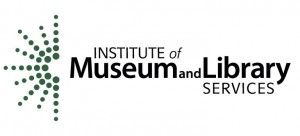 Tomorrow, the Institute of Museum and Library Services (IMLS) and the Office of Career, Technical, and Adult Education (OCTAE) at the U.S. Department of Education will host “Reboot your Digital Strategy,” a webinar that will explore national initiatives, resources, and tools that public and school librarians can use to enhance their digital literacy programming and services.
Tomorrow, the Institute of Museum and Library Services (IMLS) and the Office of Career, Technical, and Adult Education (OCTAE) at the U.S. Department of Education will host “Reboot your Digital Strategy,” a webinar that will explore national initiatives, resources, and tools that public and school librarians can use to enhance their digital literacy programming and services.
IMLS and OCTAE are working together to encourage effective collaborations between libraries and federally funded adult education programs. The issue is of national importance. The Survey of Adult Skills estimates that one in six adults, or about 36 million Americans, have low literacy. The goal of this joint effort is to enhance skills, employability, and quality of life for youths and adults with low literacy and digital literacy skills.
The “Reboot your Digital Strategy” webinar supports state and local level efforts to cross-train staff on digital literacy and builds awareness about national and regional Internet access expansion efforts. We encourage librarians to invite local partners, or potential partners, to participate in the webinar.
Webinar Details
Date: December 18, 2014
Time: 1:00–2:30 p.m. ET
Register for the Webinar
Presenters:
- Susan H. Hildreth, Director, Institute of Museum and Library Services
- Heidi Silver-Pacuilla, Team Leader, Applied Innovation and Improvement Division of Adult Education and Literacy, Office of Career, Technical, and Adult Education, U.S. Department of Education
- Sandra Toro, Senior Library Program Officer, Institute of Museum and Library Services
- Amber Petty, Program Associate, Everyone On
Librarians interested in more information about digital literacy resources can visit the Department of Education website.
Reprinted by District Dispatch–the ALA Washington Office Newsletter, December 11, 2014.
Doc Spot: Senate Report on CIA Detension and Interrogation now available online
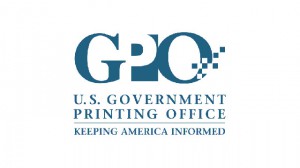 The U.S. Government Printing Office (GPO) has made available the official and authentic digital and print versions of the Report of the Senate Select Committee on Intelligence Committee Study of the Central Intelligence Agency’s Detention and Interrogation Program, together with a forward by Chairman Feinstein and Additional and Minority Views (Senate Report 113-288).
The U.S. Government Printing Office (GPO) has made available the official and authentic digital and print versions of the Report of the Senate Select Committee on Intelligence Committee Study of the Central Intelligence Agency’s Detention and Interrogation Program, together with a forward by Chairman Feinstein and Additional and Minority Views (Senate Report 113-288).
This document comprises the declassified Executive Summary and Findings and Conclusions, including declassified additional and minority views. The full classified report will be maintained by the Committee and has been provided to the Executive Branch for dissemination to all relevant agencies.
The digital version is available on GPO’s Federal Digital System (FDsys).
The print version is available for purchase at GPO’s retail and online bookstore for $29.
Enroll in a health insurance plan TODAY for coverage starting January 1
|
NEH Digital Humanities Implementation Grants – applications due Feb. 18, 2015
 National Endowment for the Humanities Digital Humanities Implementation Grants are designed to fund the implementation of innovative digital-humanities projects that have successfully completed a start-up phase and demonstrated their value to the field. Such projects might enhance our understanding of central problems in the humanities, raise new questions in the humanities, or develop new digital applications and approaches for use in the humanities. The program can support innovative digital-humanities projects that address multiple audiences, including scholars, teachers, librarians, and the public. Applications from recipients of NEH’s Digital Humanities Start-Up Grants are welcome.
National Endowment for the Humanities Digital Humanities Implementation Grants are designed to fund the implementation of innovative digital-humanities projects that have successfully completed a start-up phase and demonstrated their value to the field. Such projects might enhance our understanding of central problems in the humanities, raise new questions in the humanities, or develop new digital applications and approaches for use in the humanities. The program can support innovative digital-humanities projects that address multiple audiences, including scholars, teachers, librarians, and the public. Applications from recipients of NEH’s Digital Humanities Start-Up Grants are welcome.
Unlike NEH’s start-up grant program, which emphasizes basic research, prototyping, experimentation, and potential impact, the Digital Humanities Implementation Grants program seeks to identify projects that have successfully completed their start-up phase and are well positioned to have a major impact.
Proposals are welcome for digital initiatives in any area of the humanities. Digital Humanities Implementation Grants may involve:
- Research that brings new approaches or documents best practices in the study of the digital humanities;
- Implementation of computationally-based methods or techniques for humanities research; ¿ implementation of new digital tools for use in humanities research, public programming, or educational settings;
- Efforts to ensure the completion and long-term sustainability of existing digital resources (typically in conjunction with a library or archive);
- Scholarship that examines the history, criticism, and philosophy of digital culture and its impact on society;
- Scholarship or studies that examine the philosophical or practical implications of the use of emerging technologies in specific fields or disciplines of the humanities, or in interdisciplinary collaborations involving several fields or disciplines; or
- Implementation of new digital modes of scholarly communication that facilitate peer review, collaboration, or the dissemination of humanities scholarship for various audiences
Closing date for applications: February 18, 2015
For more information, visit http://www.neh.gov/grants/odh/digital-humanities-implementation-grants.
Posted in General, Technology
Tagged grants, National Endowment for the Humanities, NEH
Leave a comment
The Data Dude – Seniors and Technology
 This week, the Data Dude takes a look at seniors and technology. The idea here is to first regurgitate some of the data, and then make some observations. According to the Pew Research Internet Project (2014), “six in 10 adults 65 or older go online and just a little less than half have their own high-speed internet connection.” More seniors own either a tablet or an e-reader than a smartphone. When you think about this, it makes perfect sense. Not to make too many generalizations, but the obvious reasons are apparent, such as the smallness of the average smartphone screen and a larger percentage of seniors having difficulty reading the fine print. The same Pew Research study (2014) underscored the fact that the typical senior recognized the value of online information, with 94% agreeing with the statement that: “[T]he internet makes it much easier to find information today than in the past.” Many seniors, however, report that they need assistance to learn the new technologies, but are more than eager to give it a shot. While Pew notes that 77% of seniors need help from someone to walk them through using the technology, this philosophy is perhaps more aptly summed up by 93 year old Virginia Thayer: “I have absolutely no intuition about what to do with these buttons…When I grew up you just didn’t go aground pressing buttons because rather bad things happened…” Yes, Virginia, bad things might happen (we won’t sugar coat it) but most likely nothing will happen. Your grandson will promise to be patient when describing the functionality of “that thingy” in the corner of your screen when showing you how to work your device. On second thought, the good news is that there may be library programs that can help so you don’t have to bother your grandson at all, or perhaps bother him only minimally. Trust me, in most cases you will have a more positive experience with library staff, and your relationship with your grandson (or son or daughter or granddaughter) will not suffer.
This week, the Data Dude takes a look at seniors and technology. The idea here is to first regurgitate some of the data, and then make some observations. According to the Pew Research Internet Project (2014), “six in 10 adults 65 or older go online and just a little less than half have their own high-speed internet connection.” More seniors own either a tablet or an e-reader than a smartphone. When you think about this, it makes perfect sense. Not to make too many generalizations, but the obvious reasons are apparent, such as the smallness of the average smartphone screen and a larger percentage of seniors having difficulty reading the fine print. The same Pew Research study (2014) underscored the fact that the typical senior recognized the value of online information, with 94% agreeing with the statement that: “[T]he internet makes it much easier to find information today than in the past.” Many seniors, however, report that they need assistance to learn the new technologies, but are more than eager to give it a shot. While Pew notes that 77% of seniors need help from someone to walk them through using the technology, this philosophy is perhaps more aptly summed up by 93 year old Virginia Thayer: “I have absolutely no intuition about what to do with these buttons…When I grew up you just didn’t go aground pressing buttons because rather bad things happened…” Yes, Virginia, bad things might happen (we won’t sugar coat it) but most likely nothing will happen. Your grandson will promise to be patient when describing the functionality of “that thingy” in the corner of your screen when showing you how to work your device. On second thought, the good news is that there may be library programs that can help so you don’t have to bother your grandson at all, or perhaps bother him only minimally. Trust me, in most cases you will have a more positive experience with library staff, and your relationship with your grandson (or son or daughter or granddaughter) will not suffer.
About three fourths of the way through this video published by the Nebraska Community Foundation, there is mention of a program offered in Nebraska City that connects teens with seniors to provide assistance to the seniors with using iPads borrowed from the local library. That’s just the kind of help that the seniors (and perhaps even more importantly, the teens) need. As Steve Cone, vice president of membership and integrated value — (er, wait, integrated value? Really? How’s that for a word salad of ambiguity? He’d better change his title, and fast — or he might get RIF’d) at AARP told eWEEK (November 23, 2014): “The No. 1 thing I hear is that every single 40- or 50-year-old person I talk with says ‘Look, I don’t want to continue to be my mom’s or dad’s technology advisor because it takes too much time and it’s frustrating.’” So what did AARP do? They created a tablet specifically for seniors called the RealPad. The screen icons are larger, there are instructional video tutorials that cover aspects of operating the device, and 24/7 telephone customer support. The concept is good, but something tells me that any ol’ tablet could be configured this way, and perhaps provide a better value (either with the price or the specs). So shop around, seniors. Cone reports that the customer service reps can get into the device remotely (Amazon offers the same support with a mayday button on certain Kindle Fire’s), and either take control of the device or just circle/highlight certain buttons. The RealPad tech support persons are trained to “handle calls with patience and sensitivity”. That’s nice to know. Our seniors deserve patience and sensitivity, just as much as they deserve to learn new technologies. I noticed Steve changed his job title (December 3, 2014). He is now known as AARP’s executive vice president of membership. Shaka, Steve.
Getting the Groceries
Grocery shopping may seem like a pretty mundane thing to blog about. During the holiday season food – getting it, preparing it, sharing it, and reminiscing about previous culinary triumphs and disasters – is part of the celebration. The way we shop for food has changed dramatically with the advent of huge one-stop-shop chain stores and fewer locally owned markets. Fortunately, in Nebraska Memories we can see what some earlier Nebraska food stores looked like because the owners hired photographers for advertising.
 One of the earliest images is a Fred McVay photograph in the Butler County Gallery of the Hrock Meat Market. Joseph Hrock opened the butcher shop in Brainard in 1898, and sold meat from his slaughterhouse on his farm at Loma. We don’t know where the butcher shop in the 1907-1917 era John Nelson photo on the left from the Nebraska State Historical Society collection was located. Sausages, hams and ribs hang on the walls, and best of all there is a turkey on the scale. Was it going to be Thanksgiving or Christmas dinner for the Family in the Shop ?
One of the earliest images is a Fred McVay photograph in the Butler County Gallery of the Hrock Meat Market. Joseph Hrock opened the butcher shop in Brainard in 1898, and sold meat from his slaughterhouse on his farm at Loma. We don’t know where the butcher shop in the 1907-1917 era John Nelson photo on the left from the Nebraska State Historical Society collection was located. Sausages, hams and ribs hang on the walls, and best of all there is a turkey on the scale. Was it going to be Thanksgiving or Christmas dinner for the Family in the Shop ?
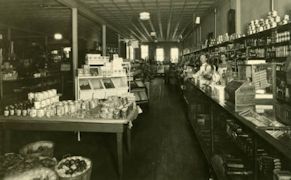 Andrew K. Greenlee, a pioneer settler in Cheyenne County, owned Greenlees Department Store in Sidney. This 1928 photo from the Cheyenne County Historical Society shows the grocery department. It looks quite large with at least two long corridors lined with fresh and canned goods carefully displayed .
Andrew K. Greenlee, a pioneer settler in Cheyenne County, owned Greenlees Department Store in Sidney. This 1928 photo from the Cheyenne County Historical Society shows the grocery department. It looks quite large with at least two long corridors lined with fresh and canned goods carefully displayed .
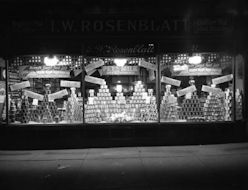 How about the spectacular I.W. Rosenblatt Food Store window display in this 1937 William Wentworth photo from the Durham Museum collection? It must have taken hours to put that together. I can’t imagine the employees actually trying to fetch something from those pyramids for a customer.
How about the spectacular I.W. Rosenblatt Food Store window display in this 1937 William Wentworth photo from the Durham Museum collection? It must have taken hours to put that together. I can’t imagine the employees actually trying to fetch something from those pyramids for a customer.
 Finally, I couldn’t resist including this World War 2 era Wentworth photo of Women shopping in a grocery store. My mother had a full-lenth muskrat coat that looked a lot like the ones these ladies are sporting. I wonder if they drove to the store themselves or were taken by their husbands like my mom, who didn’t learn to drive until the early 70s, was.
Finally, I couldn’t resist including this World War 2 era Wentworth photo of Women shopping in a grocery store. My mother had a full-lenth muskrat coat that looked a lot like the ones these ladies are sporting. I wonder if they drove to the store themselves or were taken by their husbands like my mom, who didn’t learn to drive until the early 70s, was.
Visit Nebraska Memories to search for or browse through many more historical images digitized from photographs, negatives, postcards, maps, lantern slides, books and other materials.
Nebraska Memories is a cooperative project to digitize Nebraska-related historical and cultural heritage materials and make them available to researchers of all ages via the Internet. Nebraska Memories is brought to you by the Nebraska Library Commission. If your institution is interested in participating in Nebraska Memories, see http://nlc.nebraska.gov/nebraskamemories/participation.aspx for more information, or contact Beth Goble, Historical Projects Librarian, or Devra Dragos, Technology & Access Services Director.
Posted in General, Nebraska Memories
2 Comments
Throwback Thursday: Exterior photo of the Fremont Public Library, circa 1900-1920
Posted in General
Leave a comment
The Data Dude – Paper v.s. eBook Smackdown
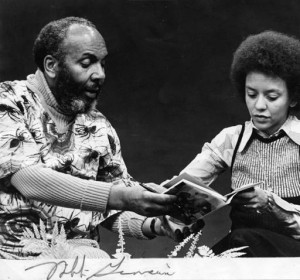 The Dude has recently changed his line of thinking when pondering paper books v.s. eBooks. I must admit part of this realization comes from my frustration with eBook deliverers, odd pricing structures, and technologies that sometimes work less than flawlessly. At any rate, there is an awareness of preferring paper in most circumstances independent of these sorts of on and off again defects. Let’s talk about some of these reasons. Stephanie Castillo describes the different ways we read as individuals, broken down into two different categories: linear and non-linear. As Castillo notes (and you can predict), linear reading is “more thoughtful, deliberate, even meditative.” Meditative? Spectacular! All of us need a little more meditation in our lives and rarely have the time for it or put forth the effort. Let’s think about it in the sense that paper reading might not replace your daily walks, bike rides, tai chi, or yoga sessions, but rather might supplement them. The notion that we can achieve meditative benefits from reading a book is refreshing, but not necessarily surprising. The digital age has fed this proliferation of non-linear reading. Arguably, non-linear reading is a product of what our culture has become, and overall it ain’t good. We live in short blips, never really taking time for genuine connection, either with ourselves or others. The effects of this often leave us feeling lonely, disconnected, stressed-out, rushed, and un-serene. How many times have we functioned in this way? I’m functioning this way right now when writing this blog post. It’s sad to admit but true. Having tab after tab open, writing one sentence, then moving to another tab (or monitor), then back. This lack of deep understanding in many of our lives is unfortunate, but there’s good news! It can be overcome. The bad news is that it isn’t mystical or magical. It takes work. It takes an effort to see others for who they are and to be vulnerable so they can see us. It takes effort to not only feel respect, humility, and commitment, but to demonstrate it. Recently, NPR’s Shankar Vedantam reported on a study that noted the benefits from talking to strangers while commuting on trains. Just talking to someone. The conclusion was that by overcoming initial fears, the result was that the social connection played an important role in improving our health and ultimately, increased happiness.
The Dude has recently changed his line of thinking when pondering paper books v.s. eBooks. I must admit part of this realization comes from my frustration with eBook deliverers, odd pricing structures, and technologies that sometimes work less than flawlessly. At any rate, there is an awareness of preferring paper in most circumstances independent of these sorts of on and off again defects. Let’s talk about some of these reasons. Stephanie Castillo describes the different ways we read as individuals, broken down into two different categories: linear and non-linear. As Castillo notes (and you can predict), linear reading is “more thoughtful, deliberate, even meditative.” Meditative? Spectacular! All of us need a little more meditation in our lives and rarely have the time for it or put forth the effort. Let’s think about it in the sense that paper reading might not replace your daily walks, bike rides, tai chi, or yoga sessions, but rather might supplement them. The notion that we can achieve meditative benefits from reading a book is refreshing, but not necessarily surprising. The digital age has fed this proliferation of non-linear reading. Arguably, non-linear reading is a product of what our culture has become, and overall it ain’t good. We live in short blips, never really taking time for genuine connection, either with ourselves or others. The effects of this often leave us feeling lonely, disconnected, stressed-out, rushed, and un-serene. How many times have we functioned in this way? I’m functioning this way right now when writing this blog post. It’s sad to admit but true. Having tab after tab open, writing one sentence, then moving to another tab (or monitor), then back. This lack of deep understanding in many of our lives is unfortunate, but there’s good news! It can be overcome. The bad news is that it isn’t mystical or magical. It takes work. It takes an effort to see others for who they are and to be vulnerable so they can see us. It takes effort to not only feel respect, humility, and commitment, but to demonstrate it. Recently, NPR’s Shankar Vedantam reported on a study that noted the benefits from talking to strangers while commuting on trains. Just talking to someone. The conclusion was that by overcoming initial fears, the result was that the social connection played an important role in improving our health and ultimately, increased happiness.
This brings me to my second point: Reading insecurity. Many of us have suffered from this, even though we might not have heard the term before. The notion of reading insecurity is aptly summed up by Katy Waldman, noting that a person “will tell you about how, when she was small, she could lose herself in a novel for hours, and now, all she can do is watch the tweets swim by like glittery fish in the river of time-she-will-never-get-back.” Sad, isn’t it? For the handful that have stayed with me this far, read that quote again. I recall as a youngster the nostalgic feeling she describes many times. One particular incident that sticks in my head was my first reading of Stephen King’s The Shining. I was so wrapped up in that book that I would read it late into the night, frequently looking over my shoulder because I experienced moments of sheer terror. As many of you can relate, the impact was that strong. Now, the Dude isn’t arguing that eBooks are all bad, but rather, that he has a newly acknowledged appreciation for paper. Thomas Moore summarizes this when he writes that paper books are “like pianos and oil paintings — superseded in some ways by new technologies, but not obliterated.” I think I’d agree with that assessment. In searching for a photo to correlate with this post, I found the photo above of Charles B. Washington and Nikki Giovanni examining a paper book. If you want more information about the photo, check it out on the Nebraska Memories page. Shaka.
Posted in Books & Reading, General, Uncategorized
Leave a comment
Sparks! Ignition Grants for Libraries and Museums – Application due 2/2/2015
Deadline: Feb. 2, 2015
Amount: $10,000 – $25,000
Awarding institution: Institute of Museum and Library Services
 The Sparks! Ignition Grants for Libraries are a special funding opportunity within the IMLS National Leadership Grants for Libraries program. These small grants encourage libraries and archives to test and evaluate specific innovations in the ways they operate and the services they provide. Sparks Grants support the deployment, testing, and evaluation of promising and groundbreaking new tools, products, services, or organizational practices. You may propose activities or approaches that involve risk, as long as the risk is balanced by significant potential for improvement in the ways libraries and museums serve their communities. Successful proposals will address problems, challenges, or needs of broad relevance to libraries and/or archives.
The Sparks! Ignition Grants for Libraries are a special funding opportunity within the IMLS National Leadership Grants for Libraries program. These small grants encourage libraries and archives to test and evaluate specific innovations in the ways they operate and the services they provide. Sparks Grants support the deployment, testing, and evaluation of promising and groundbreaking new tools, products, services, or organizational practices. You may propose activities or approaches that involve risk, as long as the risk is balanced by significant potential for improvement in the ways libraries and museums serve their communities. Successful proposals will address problems, challenges, or needs of broad relevance to libraries and/or archives.
Eligibility: Libraries that fulfill the general criteria for libraries may apply. In addition, institutions of higher education, including public and nonprofit universities, are eligible.
For more information: http://www.imls.gov/applicants/detail.aspx?GrantId=19
Throwback Thursday: Interior photo of the Strang traveling library, circa 1900
Posted in General
Leave a comment
What’s Sally Reading?
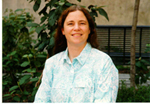 School Library Journal Announces Their Choices for the Best Books of 2014
School Library Journal Announces Their Choices for the Best Books of 2014
School Library Journal has placed their current list on the Internet, take a look here and see what title or titles you may want to add to your library’s collection. I just put one title on reserve at the library, El Deafo by Cece Bell. Cannot wait to read it! Hope you find something wonderful too!
Another title on my 2015 Summer Reading Program booklist is Killer of Enemies by Joseph Bruchac.
(The Nebraska Library Commission receives free copies of children’s and young adult books for review from a number of publishers. After review, the books are distributed free, via the Regional Library Systems, to Nebraska school and public libraries.)
Posted in Books & Reading, General, Youth Services
Leave a comment
The Data Dude on Mapping
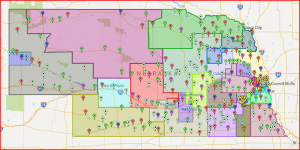 For this week, let’s talk about mapping (there is now a mapping section on the data services portion of the NLC website). But first, a promise that this will be the last reminder for the Digital Inclusion Survey (except for maybe one final e-mail to you next week if you have not yet completed it). The deadline has been extended until December 12, 2014 and there are still Three Kindle Fire HD’s up for grabs if you complete the survey. Enter your contact information at the conclusion of the survey to be eligible for the drawing. Also, don’t forget to complete the speed test by going to www.speedtest.net from a public access terminal or laptop using the library Wi-Fi. Record the download speed, upload speed, and PING. Either enter the numbers into your survey, or e-mail them to me and I will enter the figures for you.
For this week, let’s talk about mapping (there is now a mapping section on the data services portion of the NLC website). But first, a promise that this will be the last reminder for the Digital Inclusion Survey (except for maybe one final e-mail to you next week if you have not yet completed it). The deadline has been extended until December 12, 2014 and there are still Three Kindle Fire HD’s up for grabs if you complete the survey. Enter your contact information at the conclusion of the survey to be eligible for the drawing. Also, don’t forget to complete the speed test by going to www.speedtest.net from a public access terminal or laptop using the library Wi-Fi. Record the download speed, upload speed, and PING. Either enter the numbers into your survey, or e-mail them to me and I will enter the figures for you.
OK, on to the maps. Here at the Commission, a variety of mapping tools are used, including ZeeMaps, Google Fusion Tables, and Google Earth. Thanks to the help of Allana Novotny, things are looking up for understanding the complexities of these mapping tools. A word about collaboration: I mentioned Allana, and I think it’s safe to say had we not collaborated on these things, these maps either would not have gotten done or would not have had the same level of functionality. This has created a boost in my creative confidence (and even analytical thought), and I’m grateful for that (thanks, Allana). On a similar note, if you look at the legislative map mentioned in the next paragraph and have suggestions, please let me know. While the Dude thinks his collaboration with Allana has been a good thing and produced some far out maps, there are other suggestions you might bring to the table, and that is always encouraged. Likewise, if you have ideas for an entirely different map illustration, please let the Dude know and he can possibly put something together for you. The Dude promises to at least try.
Anyway, the legislative map deserves a bit of explanation. The interactive map illustrates the legislative boundaries in the state and has markers for each public library. You can certainly zoom in to your district (or any other district for that matter) for a more detailed look. If you click on one of the districts (but not a marker), a pop-up should appear that tells you the district number, the senator, and a link to the senator’s website. This information is updated with the newly elected senators. Keep in mind that the corresponding webpages might not yet be updated with the new senator names and photos and other stuff, because that is done by the Legislature, not the Library Commission. The zoomable map is especially helpful in the Lincoln or Omaha areas. The Dude added the branch locations for Lincoln and Omaha libraries. If you click on the individual markers for each library, you get a pop-up that provides you with some basic information about the library, legislative district, senator, and a link to more information from the library profile on the NLC website. The markers are colored by service population, and you can filter those by checking or unchecking boxes on the legend at the bottom. The Dude hopes the map might be helpful to you.
Now, for a hint of what the Dude might currently be pondering for data illustrations: The motion chart. The Dude mentions this because of an interest generated after watching the interesting TED Talk by Hans Rosling. If you have a chance to, check it out (if for no other reason, the entertainment value of Hans going nuts over his data illustration) and feel free to give the Dude some ideas on how such a motion chart could be generated for Nebraska Libraries, or what data might be good to illustrate. This is in the brainstorming stage at this point, so feel free to provide some collaboration, or perhaps just an idea. The Dude welcomes a distraction from all these surveys. Shaka.
Workforce Innovation and Opportunity Act (WIOA)
 President Barack Obama signed the Workforce Innovation and Opportunity Act (WIOA) into law on July 22, 2014. WIOA is designed to help job seekers access employment, education, training, and support services to succeed in the labor market and to match employers with the skilled workers they need to compete in the global economy. More information and resources are available from the U.S. Department of Labor.
President Barack Obama signed the Workforce Innovation and Opportunity Act (WIOA) into law on July 22, 2014. WIOA is designed to help job seekers access employment, education, training, and support services to succeed in the labor market and to match employers with the skilled workers they need to compete in the global economy. More information and resources are available from the U.S. Department of Labor.
In addition, the American Library Association (ALA) has released a list of resources and tools that provide more information about the Workforce Innovation and Opportunity Act (WIOA) as it relates to libraries. The Workforce Innovation and Opportunity Act allows public libraries to be considered additional One-Stop partners, prohibits federal supervision or control over selection of library resources and authorizes adult education and literacy activities provided by public libraries as an allowable statewide employment and training activity.
- Have additional questions about WIOA? Access additional WIOA resources (pdf)
- Watch the archived WIOA webinar now (Note: You must download the WebEx media player to view the video)
- Download PowerPoint slides from the webinar (ppt)
Reprinted from District Dispatch: The Official ALA Washington Office Blog, November 25, 2014.
Free webinar: The latest on Ebola
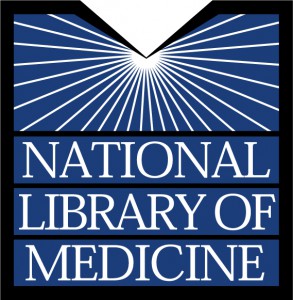 As the Ebola outbreak continues, the public must sort through all of the information being disseminated via the news media and social media. In this rapidly evolving environment, librarians are providing valuable services to their communities as they assist their users in finding credible information sources on Ebola, as well as other infectious diseases.
As the Ebola outbreak continues, the public must sort through all of the information being disseminated via the news media and social media. In this rapidly evolving environment, librarians are providing valuable services to their communities as they assist their users in finding credible information sources on Ebola, as well as other infectious diseases.
On Tuesday, December 12, 2014, library leaders from the U.S. National Library of Medicine will host the free webinar “Ebola and Other Infectious Diseases: The Latest Information from the National Library of Medicine.” As a follow-up to the webinar they presented in October, librarians from the U.S. National Library of Medicine will be discussing how to provide effective services in this environment, as well as providing an update on information sources that can be of assistance to librarians.
Speakers
- Siobhan Champ-Blackwell is a librarian with the U.S. National Library of Medicine Disaster Information Management Research Center. Champ-Blackwell selects material to be added to the NLM disaster medicine grey literature data base and is responsible for the Center’s social media efforts. Champ-Blackwell has over 10 years of experience in providing training on NLM products and resources.
- Elizabeth Norton is a librarian with the U.S. National Library of Medicine Disaster Information Management Research Center where she has been working to improve online access to disaster health information for the disaster medicine and public health workforce. Norton has presented on this topic at national and international association meetings and has provided training on disaster health information resources to first responders, educators, and librarians working with the disaster response and public health preparedness communities.
Date: December 12, 2014
Time: 2:00 PM–3:00 PM Eastern
Register for the free event
If you cannot attend this live session, a recorded archive will be available to view at your convenience. To view past webinars also done in collaboration with iPAC, please visit Lib2Gov.org.
Reprinted from District Dispatch: The Official ALA Washington Office Blog, November 21, 2014.
